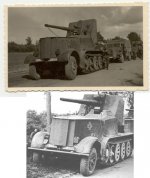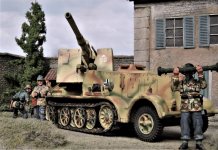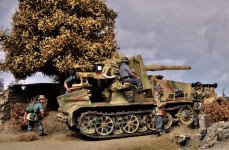You are using an out of date browser. It may not display this or other websites correctly.
You should upgrade or use an alternative browser.
You should upgrade or use an alternative browser.
Preparing to Fire (1 Viewer)
- Thread starter wwiibuff
- Start date
villagehorse
Lieutenant General
- Joined
- Feb 5, 2010
- Messages
- 15,488
One of the many converted vehicles to fulfill a role of mobile guns. This is one of K&C older pieces and still looks good. Robin.
wayne556517
Lieutenant General
- Joined
- Aug 28, 2007
- Messages
- 16,258
Brilliant Duke but it looks better in Grey.
wwiibuff
Lieutenant Colonel
- Joined
- Mar 27, 2009
- Messages
- 7,438
Brilliant Duke but it looks better in Grey.
Thanks mate. I was thinking of just that... repainting this piece to grey.
Artillery_crazy
2nd Lieutenant
- Joined
- Jun 14, 2008
- Messages
- 3,495
On a matterof historical accuracy, was not grey used at the beginning of the war and as we go towards the end of the war after D Day ...the tan with cammo comes in place due to the loss of air supremacy ...!
I alwasy thought these ombile 88s were introduced at the end of the war so never showed up in grey in the battle field....
Cheers
A_C
I alwasy thought these ombile 88s were introduced at the end of the war so never showed up in grey in the battle field....
Cheers
A_C
Thanks mate. I was thinking of just that... repainting this piece to grey.
wwiibuff
Lieutenant Colonel
- Joined
- Mar 27, 2009
- Messages
- 7,438
On a matterof historical accuracy, was not grey used at the beginning of the war and as we go towards the end of the war after D Day ...the tan with cammo comes in place due to the loss of air supremacy ...!
I alwasy thought these ombile 88s were introduced at the end of the war so never showed up in grey in the battle field....
Cheers
A_C
Actually these were used in 1939 in the invasion of Poland and later in 1940 during the Battle of France so grey would be appropriate.
wwiibuff
Lieutenant Colonel
- Joined
- Mar 27, 2009
- Messages
- 7,438
In a minute, there will be no more windows in the house behind the gun !!!!
and all the tiles from the shed will be gone
Guy{sm4}
{sm4}{sm3}
Panzer ace
Colonel
- Joined
- Mar 7, 2007
- Messages
- 8,133
Great use of a classic set.
Artillery_crazy
2nd Lieutenant
- Joined
- Jun 14, 2008
- Messages
- 3,495
On a matterof historical accuracy, was not grey used at the beginning of the war and as we go towards the end of the war after D Day ...the tan with cammo comes in place due to the loss of air supremacy ...!
I alwasy thought these ombile 88s were introduced at the end of the war so never showed up in grey in the battle field....
Cheers
A_C
Actually these were used in 1939 in the invasion of Poland and later in 1940 during the Battle of France so grey would be appropriate.
Hi wwiibuff....I am no great expert on the matter, my comment was mainly focused on the uniforms, I am pretty sure that the beige cammo style along with soldiers in that cammo pattern field jackets and using putties came into place later in 1943...never in 1940...So guess that these were the references I used on my comment..As to the halftrack, I was under the impression that these adhoc conversions came into place after 1940 and were not present during the invasion of France but during the defense of French territory after D Day....
Cheers
A_C
Last edited:
wayne556517
Lieutenant General
- Joined
- Aug 28, 2007
- Messages
- 16,258
Duke and I were talking about the vehicle, not uniforms............................
8.8cm Flak 18 (SFL) auf Zukraftwagen 12t (Sd.Kfz 8).
The concept of Bunkerflak was born in early 1938. In fact, the Heeres (German Army) wanted a weapon that could destroy enemy fortifications. The first version of the bunkerflak or Bufla was originally a Sd.Ah.201 auf Flak 18 modified and equipped with a shield towed by a Gepanzerte (armored) Zugkraftwagen 8 tons (Sd. Kfz 7). However, the Heeres-Waffenamt who oversaw the production of this version of the 88 decided to produce a second type of Bufla. In fact, it consisted of placing a 88 on the platform of a half-track type SdKfz 8 of 12 tons on DB9 chassis produced by Daimler-Benz.
During testing in the range of Kummersdorf on 23 August 1938, an officer of the Luftwaffe explained: "(...) During these tests, the high initial velocity due to the architecture of the piece and the use of piercing projectiles allowed to destroy in 30% of cases the targets between 800 to 900 meters with the first shot. Given these results, we can say that the 88 is not only able to beat small fortifications, but also can destroy a medium or heavy armored vehicle. Instead, it should be noted that the 88 gun modified in this way is no longer able to fight enemy aircraft. " This is the first time that was planned to use the 88 mm as an anti-tank weapon itself.
The first 10 vehicles were delivered during the winter 1938-39. However, these first 10 machines were also the last, in fact, another version of Bufla mounted on the chassis Famo of 18 tons was chosen.
In combat.
The Bufla was a success, were gathered in the 1. Kompanie of s.Pz.Jg.Abt.8, taking part in the Polish campaign in 1939. The commander, Hauptmann Frenzel said: "The machine allowed a good driving and good mobility. Placing the battery was fast and opening fire took only a few tens of seconds after the vehicle stopped. From this point of view, our machines are much better than the 88 mounted on a cruciform gun carriage. The mobility of our machines allowed to provide a good tactical versatility. We could change positions after two or three shots. Among other things, this allowed us not to suffer losses in Poland, the enemy artillery had no time to identify and adjust the shots on us. The infantry much appreciated our work and we are constantly asked to beat the fortifications, resistance nests or armored. In 21 days of fighting, we traveled 6,000 kilometers without having suffered any mechanical problem ".
The battery was reorganized in February 1940, composed now of 6 bufla, the other four were kept in reserve. During the Western campaign the unit provided support to the 1. and 2. Panzer and the company lost 2 Bufla. During Operation Barbarossa operated with the XXXIX AK Mot in front of Heeresgruppe Mitte. On January 29, 1942, it became in the Panzer-Jäger-Kompanie 601. But still lost two other vehicles since 22 June 1941. Finally, it was absorbed by the Panzer-Jäger-Abteilung 559 and became its 2. Kompanie. The latest operating vehicle disappeared at the end of March 1943.

8.8cm Flak 18 (SFL) auf Zukraftwagen 12t (Sd.Kfz 8).
The concept of Bunkerflak was born in early 1938. In fact, the Heeres (German Army) wanted a weapon that could destroy enemy fortifications. The first version of the bunkerflak or Bufla was originally a Sd.Ah.201 auf Flak 18 modified and equipped with a shield towed by a Gepanzerte (armored) Zugkraftwagen 8 tons (Sd. Kfz 7). However, the Heeres-Waffenamt who oversaw the production of this version of the 88 decided to produce a second type of Bufla. In fact, it consisted of placing a 88 on the platform of a half-track type SdKfz 8 of 12 tons on DB9 chassis produced by Daimler-Benz.
During testing in the range of Kummersdorf on 23 August 1938, an officer of the Luftwaffe explained: "(...) During these tests, the high initial velocity due to the architecture of the piece and the use of piercing projectiles allowed to destroy in 30% of cases the targets between 800 to 900 meters with the first shot. Given these results, we can say that the 88 is not only able to beat small fortifications, but also can destroy a medium or heavy armored vehicle. Instead, it should be noted that the 88 gun modified in this way is no longer able to fight enemy aircraft. " This is the first time that was planned to use the 88 mm as an anti-tank weapon itself.
The first 10 vehicles were delivered during the winter 1938-39. However, these first 10 machines were also the last, in fact, another version of Bufla mounted on the chassis Famo of 18 tons was chosen.
In combat.
The Bufla was a success, were gathered in the 1. Kompanie of s.Pz.Jg.Abt.8, taking part in the Polish campaign in 1939. The commander, Hauptmann Frenzel said: "The machine allowed a good driving and good mobility. Placing the battery was fast and opening fire took only a few tens of seconds after the vehicle stopped. From this point of view, our machines are much better than the 88 mounted on a cruciform gun carriage. The mobility of our machines allowed to provide a good tactical versatility. We could change positions after two or three shots. Among other things, this allowed us not to suffer losses in Poland, the enemy artillery had no time to identify and adjust the shots on us. The infantry much appreciated our work and we are constantly asked to beat the fortifications, resistance nests or armored. In 21 days of fighting, we traveled 6,000 kilometers without having suffered any mechanical problem ".
The battery was reorganized in February 1940, composed now of 6 bufla, the other four were kept in reserve. During the Western campaign the unit provided support to the 1. and 2. Panzer and the company lost 2 Bufla. During Operation Barbarossa operated with the XXXIX AK Mot in front of Heeresgruppe Mitte. On January 29, 1942, it became in the Panzer-Jäger-Kompanie 601. But still lost two other vehicles since 22 June 1941. Finally, it was absorbed by the Panzer-Jäger-Abteilung 559 and became its 2. Kompanie. The latest operating vehicle disappeared at the end of March 1943.

villagehorse
Lieutenant General
- Joined
- Feb 5, 2010
- Messages
- 15,488
Looks even better with the full crew. Robin.
Horus
Brigadier General
- Joined
- Nov 20, 2015
- Messages
- 12,251
Duke and I were talking about the vehicle, not uniforms............................
8.8cm Flak 18 (SFL) auf Zukraftwagen 12t (Sd.Kfz 8).
The concept of Bunkerflak was born in early 1938. In fact, the Heeres (German Army) wanted a weapon that could destroy enemy fortifications. The first version of the bunkerflak or Bufla was originally a Sd.Ah.201 auf Flak 18 modified and equipped with a shield towed by a Gepanzerte (armored) Zugkraftwagen 8 tons (Sd. Kfz 7). However, the Heeres-Waffenamt who oversaw the production of this version of the 88 decided to produce a second type of Bufla. In fact, it consisted of placing a 88 on the platform of a half-track type SdKfz 8 of 12 tons on DB9 chassis produced by Daimler-Benz.
During testing in the range of Kummersdorf on 23 August 1938, an officer of the Luftwaffe explained: "(...) During these tests, the high initial velocity due to the architecture of the piece and the use of piercing projectiles allowed to destroy in 30% of cases the targets between 800 to 900 meters with the first shot. Given these results, we can say that the 88 is not only able to beat small fortifications, but also can destroy a medium or heavy armored vehicle. Instead, it should be noted that the 88 gun modified in this way is no longer able to fight enemy aircraft. " This is the first time that was planned to use the 88 mm as an anti-tank weapon itself.
The first 10 vehicles were delivered during the winter 1938-39. However, these first 10 machines were also the last, in fact, another version of Bufla mounted on the chassis Famo of 18 tons was chosen.
In combat.
The Bufla was a success, were gathered in the 1. Kompanie of s.Pz.Jg.Abt.8, taking part in the Polish campaign in 1939. The commander, Hauptmann Frenzel said: "The machine allowed a good driving and good mobility. Placing the battery was fast and opening fire took only a few tens of seconds after the vehicle stopped. From this point of view, our machines are much better than the 88 mounted on a cruciform gun carriage. The mobility of our machines allowed to provide a good tactical versatility. We could change positions after two or three shots. Among other things, this allowed us not to suffer losses in Poland, the enemy artillery had no time to identify and adjust the shots on us. The infantry much appreciated our work and we are constantly asked to beat the fortifications, resistance nests or armored. In 21 days of fighting, we traveled 6,000 kilometers without having suffered any mechanical problem ".
The battery was reorganized in February 1940, composed now of 6 bufla, the other four were kept in reserve. During the Western campaign the unit provided support to the 1. and 2. Panzer and the company lost 2 Bufla. During Operation Barbarossa operated with the XXXIX AK Mot in front of Heeresgruppe Mitte. On January 29, 1942, it became in the Panzer-Jäger-Kompanie 601. But still lost two other vehicles since 22 June 1941. Finally, it was absorbed by the Panzer-Jäger-Abteilung 559 and became its 2. Kompanie. The latest operating vehicle disappeared at the end of March 1943.
View attachment 285119
Interesting read Wayne. Thanks or posting.
Steve
Horus
Brigadier General
- Joined
- Nov 20, 2015
- Messages
- 12,251
Here's another shot this time of the whole set which has 5 total figures.... 4 loose standing figures along with the fixed gunner.
Another great photo Duke. Almost makes me want one !:salute::
Steve
Users who are viewing this thread
Total: 2 (members: 0, guests: 2)



